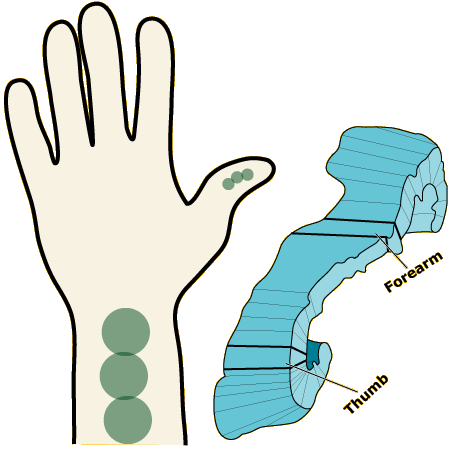Two-Point Touch Thresholds

Introduction
Take a paperclip and bend it into the shape shown below, so that the two ends of the paperclip are pointing downward. Further, adjust the paperclip so that the two points are about two millimeters (one-eighth of an inch) apart.

Once you have prepared your paperclip, touch it to the pad of your thumb, so that both ends are making contact at the same time. You should be able to feel two distinct points touching your skin. Next, rotate the paperclip slightly so that only one of the ends is touching you; you should now feel a single point touching your skin.
Do the same thing with the paperclip on your forearm (just above or below where a watch strap would be). You should find that on this portion of your body, you cannot discriminate between whether one or both ends of the paperclip are touching your skin. (If you can feel two distinct points on your forearm, move the two ends of the paperclip closer together, then repeat both parts of the demonstration.)
The interactive figure at left illustrates what is going on. The green circles on the hand and forearm in the figure represent receptive fields (RFs) for somatosensory neurons. The red dots on the slice of somatosensory cortex represent the neurons that the RFs ultimately link up to. (See the activity on the Sensory Homunculus for more about somatosensory cortex.)
As you can see, three neurons in the thumb section of somatosensory cortex correspond to the three RFs in the thumb, and three neurons in the forearm section correspond to the three RFs in the forearm. (You actually have thousands of somatosensory neurons in your thumb and forearm and the RFs of these neurons are considerably smaller than represented here. The figure has been simplified to make it easier to use in this activity.)
Instructions
Click and drag the purple “paperclip” around over the hand on the left. When the clip is over a somatosensory receptor’s receptive field (green dots), corresponding neurons that receive input from that receptor will flash in the cortex slice on the right (red dots).
About Columns
Click and drag the small purple paperclip (that is in the middle of the hand in the figure) so that its two ends are over the RFs in the thumb and then release the mouse button (or click here to make the paperclip jump into position). Since the RFs on the thumb are small, you will easily be able to place the paperclip so that one end is touching one RF and the other end is touching another RF. Consequently, two different cortical neurons will become activated (they will start flashing), and you will feel the two points separately.
Now click and drag the virtual paperclip over the forearm and release the mouse button (or click here to make it jump there). Since the RFs on the forearm are so much larger than those in the thumb, it will be difficult to place the paperclip so that the two ends are touching different RFs. Instead, both ends will usually fall within the same RF.
Here is the crux of why you cannot feel whether two ends or one end of the paperclip are touching your forearm: If both ends of the paperclip are falling on a single somatosensory neuron RF, then only one cortical neuron will be activated. Two points are touching your skin in reality, but your brain’s representation of reality is constructed from what your sensory neurons tell it. Therefore, you only feel a single object.
This situation is directly analogous to the visual system. Remember that ganglion receptive fields in the eye are much larger in the periphery of your vision than in your central vision. As a result, visual acuity is much sharper for objects you are looking at directly than for objects you see out of the corner of your eye.
Arranging sensory receptors in this way makes sense in touch for the same reason it makes sense in vision. Your fingertips are like a somatosensory fovea: When you want to discover the details of an object using somatosensation, you touch the object with your fingers. Therefore, you require high acuity in your fingertips to register fine details. You also require touch receptors on your forearm in case this body part happens to make contact with an object. But if you want to examine the object more closely, you will move your fingers into place to do so, just as you would shift your eyes to fixate on an interesting object that you initially saw in your peripheral vision.